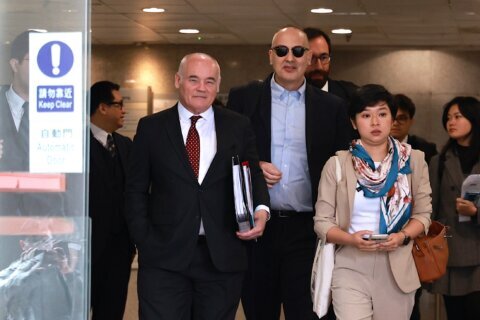WASHINGTON (AP) — A U.S. drone strike in Afghanistan this weekend killed Ayman al-Zawahri, who helped Osama bin Laden plot the Sept. 11, 2001, attacks on the United States and helped al-Qaida survive and spread in the years after. By finding and striking al-Zawahiri, President Joe Biden said, the U.S. was ensuring that Afghanistan under the Taliban would never again become a base for attacks on the rest of the world, as it was in 2001.
A look at the al-Qaida leader, who evaded U.S. capture for 21 years after the suicide airliner attacks that in many ways changed America and its relations with the rest of the world.
WHO WAS AYMAN AL-ZAWAHRI?
Americans who lived through the 9/11 attacks may not remember al-Zawahri’s name, but many know his face, more than two decades on: a man in glasses, slightly smiling, invariably shown in photos by the side of bin Laden as the two arranged the strike on the United States.
An Egyptian, al-Zawahri was born June 19, 1951, to a comfortable family in a leafy, drowsy Cairo suburb. Religiously observant from boyhood, he immersed himself in a violent branch of a Sunni Islamic revival that sought to replace the governments of Egypt and other Arab nations with a harsh interpretation of Islamic rule.
Al-Zawahri worked as an eye surgeon as a young adult, but also roamed Central Asia and the Middle East, witnessing Afghans’ war against Soviet occupiers in that country, and meeting young Saudi Osama bin Laden and other Arab militants rallying to help Afghanistan expel Soviet troops.
He was one of hundreds of militants captured and tortured in Egyptian prison after Islamic fundamentalists’ assassination of President Anwar Sadat in 1981. Biographers say the experience further radicalized him. Seven years later, al-Zawahri was present when bin Laden founded al-Qaida.
Al-Zawahri merged his own Egyptian militant group with al-Qaida. He brought al-Qaida organizational skill and experience — honed underground in Egypt, evading Egyptian intelligence — that allowed al-Qaida to organize cells of followers and strike around the world.
WHY WAS AL-ZAWAHRI IMPORTANT?
After the years of quietly assembling the suicide attackers, funds and plans for the Sept. 11 attack, Zawahri and lieutenants ensured that al-Qaida survived the global manhunt that followed to attack again.
On the run after 9/11, al-Zawahri rebuilt al-Qaida leadership in the Afghan-Pakistan border region and was the supreme leader over branches in Iraq, Asia, Yemen and beyond. With a credo of targeting near and far enemies, al-Qaida after 9/11 carried out years of unrelenting attacks: in Bali, Mombasa, Riyadh, Jakarta, Istanbul, Madrid, London and beyond. Attacks that killed 52 people in London in 2005 were among al-Qaida’s last devastating attacks in the West, as drone strikes, counterterror raids and missiles launched by the U.S. and others killed al-Qaida-affiliated fighters and shattered parts of the network.
HOW WAS HE KILLED?
Around sunrise Sunday, Al-Zawahri walked out on the balcony of a house in Kabul, Afghanistan. He apparently lingered outside on the balcony, as U.S. intelligence had noted he often did. On this day, a U.S. drone fired two Hellfire missiles at the al-Qaida leader as he stood, according to U.S. officials, speaking on condition of anonymity to discuss the strike.
His presence in Afghanistan had been widely suspected for some time, analysts said. U.S. officials learned this year that Zawahri’s wife and other family members had moved to a safe house in Kabul recently. Zawahri soon followed, the senior administration officials said.
U.S. officials, joined by top leaders all the way up to, eventually, Biden, spent careful months confirming his identity — and his fateful practice of standing alone on that same balcony — and planned the strike.
WHAT DOES HIS KILLING MEAN FOR AL-QAIDA?
It depends on which al-Qaida lieutenant succeeds him. And after decades of U.S. and other strikes, that’s a pretty thin group. Al-Qaida expert Ali Soufan points to an Egyptian, Saif al-Adl, as one of the candidates to be dreaded by the West, given al-Adl’s revered status within al-Qaida, his experience, and the potential of his charisma to draw back al-Qaida defectors who’ve moved to other groups.
But al-Qaida overall now faces a succession crisis and a shaky future. That includes rivalries against aggressive upstart extremist groups that came into being after 9/11 and also have a presence in Afghanistan.
Charles Lister, another expert in violent extremist networks, wrote after the killing that the nature and spread of conflicts around the Middle East, Africa and South Asia today favor locally focused jihadist organizations rather than globally focused ones.
Al-Qaida’s next leader will have to prove his relevance to “self-confident affiliates that have been more willing to push back against a central leadership perceived as detached from the realities of conflicts thousands of miles away,” Lister wrote.
DID THE TALIBAN KNOW AL-ZAWAHRI WAS IN AFGHANISTAN?
Undoubtedly, U.S. officials said. It wasn’t clear Monday how long al-Zawahri had been in Afghanistan, but his presence there had been widely rumored for some time, said Asfandyar Mir, a Central Asia expert with the U.S. Institute of Peace. Not only that: The house where Al-Zawahri was living with his family was owned by a top aide to senior Taliban leader Sirajuddin Haqqani, according to a senior U.S. intelligence official.
It could be that someone among the Taliban sold out al-Zawahri and his family to U.S. or other foreign interests. But it was a Taliban government that took in al-Qaida’s leaders in the mid-1990s and allowed them to plot the 9/11 attacks there, sparking the 20-year U.S.-led war there. The worry after al-Zawahri’s death in Afghanistan’s capital was that the Taliban were allowing armed extremist organizations a home in Afghanistan again in the wake of the U.S. withdrawal, as the West had feared.
Copyright © 2025 The Associated Press. All rights reserved. This material may not be published, broadcast, written or redistributed.







